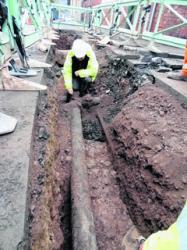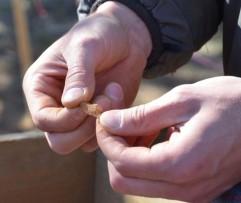INSTITUT SUPERIEUR D'ANTHROPOLOGIE
INSTITUTE OF ANTHROPOLOGY
ONLINE COURSES / COURS A DISTANCE
INSCRIPTION 2012 / Session II : Avril 2012
REGISTRATION 2012 / Term II : April 2012
ROYAUME UNI –  Monmouth - Excavations for the replacement of gas mains by Amec have been continuing for some weeks and have now reached the Monk Street/Dixton Road traffic lights. The work is being monitored by members of Monmouth Archaeology (the professional wing of Monmouth Archaeological Society) who have been recording a series of ancient roads as well as features associated with the town's northern medieval defences. The most interesting revelations have been the sequence of medieval and later road surfaces which lie over a stone cobbled road at one metre below the modern road surface and which may be Roman – possibly part of the Roman town of ‘Blestium’ or of the middle 1st century Roman Fort. The lowest road was superseded by another which was composed of bloomery iron slag. This road must be medieval or earlier because by the 1600s it was discovered that there was a considerable amount of iron remaining in the slag and that it could be re-smelted in a blast furnace such as one at Tintern. Previously the council had been using the huge drifts of iron slag which were lying around the town from the Roman and medieval bloomeries – especially on the banks of the Wye and at Overmonnow – for metalling the roads. Now they realised that the slag was valuable and cinder ‘mining’ became a major feature of town life, with large open-cast mines appearing in several areas while at Overmonnow the Cinder ‘Hill’ was completely removed. The roads above the one made of iron slag are all quite different, being made of broken stone, pebbles and rubble, up to the modern tarmacadam surfaces.
Monmouth - Excavations for the replacement of gas mains by Amec have been continuing for some weeks and have now reached the Monk Street/Dixton Road traffic lights. The work is being monitored by members of Monmouth Archaeology (the professional wing of Monmouth Archaeological Society) who have been recording a series of ancient roads as well as features associated with the town's northern medieval defences. The most interesting revelations have been the sequence of medieval and later road surfaces which lie over a stone cobbled road at one metre below the modern road surface and which may be Roman – possibly part of the Roman town of ‘Blestium’ or of the middle 1st century Roman Fort. The lowest road was superseded by another which was composed of bloomery iron slag. This road must be medieval or earlier because by the 1600s it was discovered that there was a considerable amount of iron remaining in the slag and that it could be re-smelted in a blast furnace such as one at Tintern. Previously the council had been using the huge drifts of iron slag which were lying around the town from the Roman and medieval bloomeries – especially on the banks of the Wye and at Overmonnow – for metalling the roads. Now they realised that the slag was valuable and cinder ‘mining’ became a major feature of town life, with large open-cast mines appearing in several areas while at Overmonnow the Cinder ‘Hill’ was completely removed. The roads above the one made of iron slag are all quite different, being made of broken stone, pebbles and rubble, up to the modern tarmacadam surfaces.
There was no east-west road at the traffic lights until Priory Street and the New Dixton Road was built in the 19th century (to relieve traffic in Church Street which until then was part of the main road to west Wales). Other interesting remains recorded are areas of stonework which are associated with, or are part of, the Monks’ Gate which was built in around AD1300. This may have been a bigger construction than was previously realised and was set further away from a large 11th or 12th century defensive ditch which crosses the road on route from the River Monnow to the River Wye, cutting off the peninsula on the north and the east.
http://www.monmouth-today.co.uk/news.cfm?id=7504&headline=More%20ancient%20roads%20discovered%20under%20Monmouth
USA –  Bladensburg - An archaeological dig at the Bladensburg Public Library has uncovered artifacts that date from 2000 BC to the 19th century said State Highway Administration archaeologist Dr. Julie Schablistky. “Based on historic maps, we ended up finding that there was a school here back in the 1840s and it was probably one of the first in Bladensburg,” Schablitsky said. In addition, the archaeology team has found evidence that Native Americans used the area as temporary campgrounds. “An arrowhead we found seems to date to the late archaic, so that’s about several thousand years ago,” Schablitsky said. “Right now [the artifacts] are concentrated with a lot of quartzite and some other soft materials.” Deposits have been found up to six feet underground, most likely buried by erosion and sediment carried up by the flooding of the Anacostia River. Both of these processes occurred over the period of thousands of years, Schablitsky said.
Bladensburg - An archaeological dig at the Bladensburg Public Library has uncovered artifacts that date from 2000 BC to the 19th century said State Highway Administration archaeologist Dr. Julie Schablistky. “Based on historic maps, we ended up finding that there was a school here back in the 1840s and it was probably one of the first in Bladensburg,” Schablitsky said. In addition, the archaeology team has found evidence that Native Americans used the area as temporary campgrounds. “An arrowhead we found seems to date to the late archaic, so that’s about several thousand years ago,” Schablitsky said. “Right now [the artifacts] are concentrated with a lot of quartzite and some other soft materials.” Deposits have been found up to six feet underground, most likely buried by erosion and sediment carried up by the flooding of the Anacostia River. Both of these processes occurred over the period of thousands of years, Schablitsky said.
http://hyattsville.patch.com/articles/history-in-the-backyard
ROYAUME UNI – Manchester - Sites in Leigh, Bury, Stockport and Oldham will be the first to be explored as part of Dig Greater Manchester, an ambitious project combining digs with workshops and lectures in 11 boroughs. The first excavation will be the medieval Etherstone Hall in Leigh during March. The Hall has origins tracing back to 1415 and volunteers from the community and schools will work with Salford University's archaeologists to find out more about its moat, discover pottery and other remains, and trace its history right up to the late 1970s. Also included this year, but yet to be detailed are sites in Bury, Stockport and Oldham.
http://www.placenorthwest.co.uk/news/archive/11116-four-year-archaeological-programme-begins-in-march.html
USA - Middletown - Now, through an upcoming archeological project conducted by the University, students will begin to unearth the origins of the Middletown community. The dig will focus on the lost stories of the community of the African Methodist Episcopal (AME) Zion Church that has been in Middletown since 1823. Church membership strengthened the black community during the difficult post-Civil War years. In accordance with the church’s goals, Leverett Beman, a shoemaker from a family of strong abolitionists and black rights activists, made plans in 1847 to develop a neighborhood in this area where blacks could own property, hold stable jobs, and live in a safe, tight-knit community. The Beman Triangle, located between Cross, Knowles, and Vine Streets, consists of 18 houses built between 1840 and 1959. The community lasted until the late 1920s, when more and more jobs began to disappear at the onset of the Great Depression. Outside investors took over, and many Swedish and Italian immigrants moved into the area.
http://wesleyanargus.com/2012/02/27/31119/